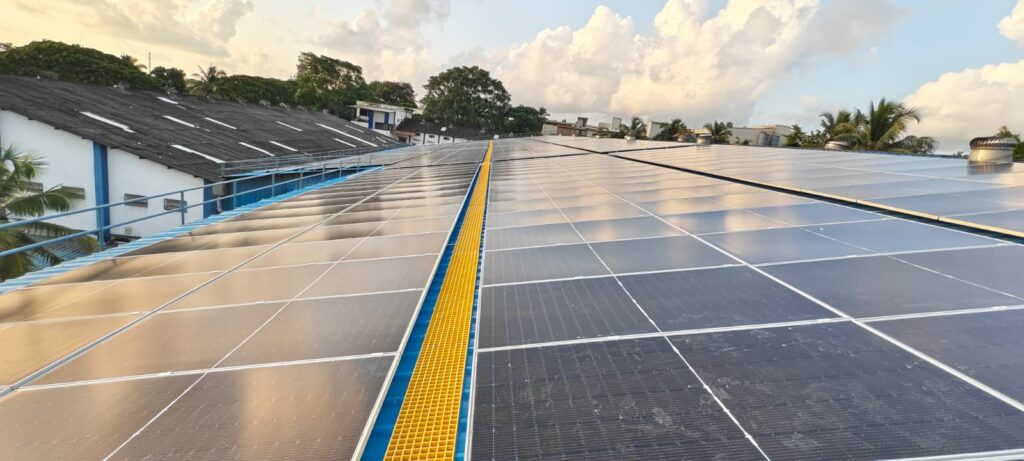Solar Rooftop System
In an era where renewable energy is shaping the future, solar rooftop systems have emerged as a game-changer. These systems not only provide sustainable energy solutions but also offer a pathway to energy independence. Whether you’re a homeowner, a business owner, or a sustainability enthusiast, solar rooftop systems have something remarkable to offer.
Download Brochure
Testimonial


FAQs
How does a solar rooftop system work?
Solar panels capture sunlight and convert it into direct current (DC) electricity. An inverter converts the DC into alternating current (AC) for use in your home or business.
Can a solar rooftop system power my entire home or office?
Yes, depending on the size of the system and your energy requirements, a solar rooftop system can meet all or part of your electricity needs.
What is the lifespan of a solar rooftop system?
Most solar panels come with a lifespan of 25–30 years, and inverters typically last 10–15 years with proper maintenance.
Is my roof suitable for installing solar panels?
A roof is suitable if it has enough space, is structurally sound, and receives adequate sunlight without obstructions like trees or tall buildings.
How long does it take to install a solar rooftop system?
Installation typically takes 2–5 days, depending on the complexity of the project.
What maintenance is required for a solar rooftop system?
Minimal maintenance is needed, such as cleaning the panels every few months and periodic system checks to ensure efficiency.
How much does a solar rooftop system cost?
Costs vary depending on system size and quality, ranging from ₹40,000 to ₹1,00,000 per kW in India.
Are there any government subsidies for solar rooftops?
Yes, many governments offer subsidies, tax benefits, and incentives for installing solar rooftop systems. In India, subsidies can cover up to 40% of the cost for residential systems.
How much can I save with a solar rooftop system?
Savings depend on your electricity consumption, but a solar system can reduce your electricity bills by 50–90%.
What happens during a power outage?
If you don’t have a battery backup or hybrid system, your solar system will stop functioning during an outage for safety reasons.
Does the system work during cloudy days or at night?
Solar panels produce less electricity on cloudy days and none at night. A battery backup or grid connection can provide power during these times.
What is net metering?
Net metering allows you to send excess electricity generated by your system to the grid, and you receive credits to offset future electricity bills.

What is a Solar Rooftop System?
A solar rooftop system involves the installation of solar panels on the rooftops of buildings to convert sunlight into electricity. These systems use photovoltaic (PV) technology to capture sunlight and generate power, providing an eco-friendly alternative to conventional electricity sources.

How Do Solar Rooftop Systems Work?
- Solar Panels Capture Sunlight: PV panels absorb sunlight and convert it into direct current (DC) electricity.
- Inverter Converts DC to AC: Since most appliances run on alternating current (AC), an inverter transforms DC electricity into AC.
- Power Your Needs: The generated electricity powers your home or business. Excess power can be stored in batteries or fed into the grid through net metering.

Benefits Of Solar Rooftop System
Cost Savings
Solar rooftop systems can significantly reduce electricity bills.
Sustainable
By relying on the sun's energy, you reduce your carbon footprint and climate change.
Independence
Generating your own electricity makes you less dependent on power companies.
Incentives & Subsidy Program
Many governments offer subsidies, tax benefits, and net metering policies to encourage solar adoption.
Increase Property Value
Generating your own electricity makes you less dependent on power companies.
Low Maintenance Cost
With occasional cleaning and routine checks, these systems can last 25 years or more, ensuring a hassle-free energy solution.
Types of Solar Rooftop System

Ongrid System
These systems are connected to the main power grid. They provide electricity during the day, and any excess is sent back to the grid, for which users often receive credits.

Offgrid System
Off-grid systems operate independently of the grid and use batteries to store electricity, making them ideal for remote locations.

Hybrid System
Combining the benefits of both grid-connected and off-grid systems, hybrid systems use batteries for storage while still being connected to the grid for backup.
Steps To Install A Solar Rooftop
Site Assessment
A professional evaluates your rooftop's suitability for solar panels, considering factors like sunlight availability, roof orientation, and space.
Design & Planning
Based on your energy requirements, experts design a system tailored to your needs.
Solar Panel Installation
Panels, inverters, and other components are installed on your roof, followed by wiring and grid connection
Maintenance & Monitoring
Solar systems require minimal maintenance. Regular cleaning and periodic checks ensure optimal performance.
Why Choose Solar Rooftop Systems for Your Home or Business?
Adopting solar energy isn’t just an investment in your property; it’s an investment in the planet’s future. With rising energy costs and increasing environmental concerns, solar rooftop systems offer a smart, sustainable, and long-term solution to power needs.

The sun is an infinite resource, and with a solar rooftop system, you can harness its power to light up your life. Whether you’re aiming to cut down on electricity bills or make a positive environmental impact, going solar is a step in the right direction.
Are you ready to take the leap? At Thangam Energy Solutions, we specialize in offering customized solar solutions to help you embrace the solar revolution. Let us guide you on your journey toward a greener tomorrow!
Fulfilling the dreams of every house owner to move towards sustainable energy
